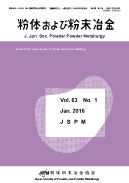All issues

Volume 63, Issue 2
February
Displaying 1-11 of 11 articles from this issue
- |<
- <
- 1
- >
- >|
Summarization
-
Yuzo SHIMADA2016 Volume 63 Issue 2 Pages 55-
Published: February 15, 2016
Released on J-STAGE: March 05, 2016
JOURNAL OPEN ACCESSDownload PDF (200K) -
Shigeki NAKAGAWA2016 Volume 63 Issue 2 Pages 56-
Published: February 15, 2016
Released on J-STAGE: March 05, 2016
JOURNAL OPEN ACCESSDownload PDF (202K) -
Chikara OHTSUKI2016 Volume 63 Issue 2 Pages 57-
Published: February 15, 2016
Released on J-STAGE: March 05, 2016
JOURNAL OPEN ACCESSDownload PDF (205K) -
Hideaki MATSUBARA2016 Volume 63 Issue 2 Pages 58-
Published: February 15, 2016
Released on J-STAGE: March 05, 2016
JOURNAL OPEN ACCESSDownload PDF (167K) -
Yuichi SHIMAKAWA2016 Volume 63 Issue 2 Pages 59-
Published: February 15, 2016
Released on J-STAGE: March 05, 2016
JOURNAL OPEN ACCESSDownload PDF (176K)
Paper
Paper
-
Kazuya NISHI, Yasuhisa AONO, Kazutaka OKAMOTO, Takao IMAGAWA, Kenichi ...2016 Volume 63 Issue 2 Pages 63-69
Published: February 15, 2016
Released on J-STAGE: March 05, 2016
JOURNAL OPEN ACCESSSoft magnetic composite (SMC) cores, produced by compacting insulated iron powders, are expected to improve the efficiency of motors and boost converters. Low-cost water atomized iron powders are used as raw materials for SMC cores. Since the water atomized iron powders containing a large amount of oxygen impurity, there is a problem that the magnetic properties of the SMC cores are deteriorated due to oxygen impurity. First, green compacts were made by several kinds of water atomized iron powders in which oxygen content levels are different, then were annealed in vacuum. It was found that the coercivity and the hardness of these compacts were proportional to the oxygen concentration in iron powders. By TEM observation of the compacts, it was confirmed that there were very fine oxide particles smaller than 10 nm in inside of the iron powders, and that the number density of oxide particle increase with increase in oxygen concentration. From a correlation between coercivity and particle number density, it was predicted that the existence of ultrafine oxide particles caused the increase in coercivity.View full abstractDownload PDF (845K) -
Yoshihiro TANAKA, Kinya KAWASE, Hajime KOHNO2016 Volume 63 Issue 2 Pages 70-76
Published: February 15, 2016
Released on J-STAGE: March 05, 2016
JOURNAL OPEN ACCESSPrevention of cracks during compaction is one of the most important quality issues in the PM industry. Therefore, various types of the mechanisms of crack formation have been studied both in the academic and the practical areas. However, the mechanism of the formation of the micro crack, which is often formed on the boss near the corner of a step and not at the corner of a step, has not been clarified. In this study, a powder mix of Fe-Cu-C system was compacted with a stepped die, to investigate the influence of the powder compact geometry on the micro crack formation. The influence of the powder compact geometry on micro crack formation is discussed from the view points of the powder compaction experiment and FEM analysis.View full abstractDownload PDF (1693K)
New Techniques and New Products
New Techniques and New Products
-
Hiroshi TAKASUGI, Shin TERAKI, Tsuyoshi KUROKAWA, Issei AOKI2016 Volume 63 Issue 2 Pages 79-81
Published: February 15, 2016
Released on J-STAGE: March 05, 2016
JOURNAL OPEN ACCESSDownload PDF (621K) -
Masatoshi TERANISHI, Kazuto NISHIDA, Takayoshi NAKANO, Hideki ARAKI, T ...2016 Volume 63 Issue 2 Pages 82-84
Published: February 15, 2016
Released on J-STAGE: March 05, 2016
JOURNAL OPEN ACCESSDownload PDF (720K) -
Takayuki INOUE, Haruhiko ISHIZAKA, Yoshio NAKASHIMA, Hiroshi SASAI, Ta ...2016 Volume 63 Issue 2 Pages 85-87
Published: February 15, 2016
Released on J-STAGE: March 05, 2016
JOURNAL OPEN ACCESSDownload PDF (847K)
JSPM Announcements
-
2016 Volume 63 Issue 2 Pages Pref2_1-
Published: February 15, 2016
Released on J-STAGE: March 05, 2016
JOURNAL OPEN ACCESSDownload PDF (179K)
- |<
- <
- 1
- >
- >|